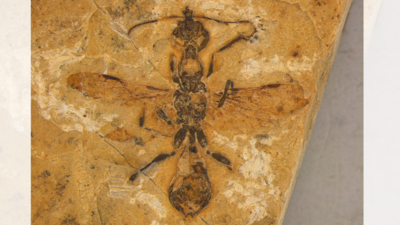In a groundbreaking discovery, scientists in Brazil have discovered the world’s oldest known ant fossil of a 113-million-year-old specimen of a fearsome predator known as a “hell ant.” Unearthed from limestone in northeastern Brazil, this fossil dramatically reshapes our understanding of ant evolution, pushing back their known history by over 13 million years. Published in Current Biology, the study reveals that ants were already diverse and widespread during the time of dinosaurs. With scythe-like jaws used to impale prey, this ancient insect highlights how complex and specialised ants were, even in their earliest forms.
What are hell ants
Hell ants are an extinct subfamily of ants known scientifically as Haidomyrmecinae. They lived during the Cretaceous period, between 145 and 66 million years ago. What makes them especially fascinating is their unique jaw structure: instead of moving side to side like modern ants, their scythe-shaped jaws curved upward and were likely used to impale or pin down prey. This brutal hunting method gives them their dramatic nickname.
These ants are among the most anatomically distinct ever discovered and are considered one of the most intriguing ant groups in evolutionary history.
What does the 113-year-old hell ant fossil reveal
The newly discovered fossil is a winged female ant, possibly a queen, and was found in limestone deposits from the Crato Formation in northeastern Brazil. It has been named Vulcanidris cratensis, combining “Vulcano,” the name of the family who donated the rock, and “idris,” a suffix commonly used in ant taxonomy meaning “the provident one.”
At 113 million years old, the fossil predates the previously oldest known ant specimens, found in amber in Myanmar and France, by approximately 13 million years.
How scientists peek into the fiery preying technique of hell ants
Lead researcher Anderson Lepeco and his team at the Museu de Zoologia da Universidade de Sao Paulo used a high-resolution 3D imaging technique called micro-computed tomography to examine the fossil trapped in limestone. This allowed scientists to study the insect’s internal structures, particularly its jaws, in extraordinary detail. when a small insect came close, the hell ant would quickly snap its jaws shut in an upward motion, trapping the prey against its horn. This action would pierce or pin the prey in place, like a fork stabbing food against a plate.
This style of attack was very different from modern ants, whose jaws usually move side to side. Hell ants’ upward-striking jaws gave them an evolutionary edge in ambushing and killing prey.
“When I started to look at it and compared it to fossils from Myanmar, I was just shocked,” said Lepeco. “I was very, very excited. I was jumping through the lab.”
The incredible world of ants
Ants have fascinated scientists for decades, not only because of their ancient origins but also due to their incredible capabilities today. These tiny insects are among the most ecologically dominant animals on Earth, with an estimated population of nearly 20 quadrillion. Found on every continent except Antarctica, that’s about 2.5 million ants for every human on the planet.
They are known for their complex social organisation, advanced communication systems, and even medical skills. Some species can perform amputations to save wounded nestmates. Others can be trained to use their keen sense of smell to detect diseases such as cancer. Their sex lives and reproductive strategies also surprise researchers, making ants a truly remarkable group in the animal kingdom.
Why this discovery matters
The fossil offers the earliest undisputed evidence of ants in South America and pushes back the known presence of ants on the continent by over 60 million years. According to Corentin Jouault, an evolutionary biologist at the University of Oxford, this is a breakthrough in paleomyrmecology, the study of ancient ants. It also supports the theory that ants were already widespread during the time of Gondwana, the ancient supercontinent that included present-day South America, Africa, India, and other landmasses.
What lies ahead
Scientists now plan to expand their research by building a larger database of ancient ant fossils to better understand how ants evolved. This discovery also highlights the importance of museum collections, as the fossil was found in rocks that had been stored for years, unnoticed.
As researchers continue to explore both field sites and forgotten drawers in collections, the fiery story of hell ants serves as a reminder that some of Earth’s most historic secrets are still waiting to be uncovered.












More Stories
Left alone by humans, wildlife returns to the Eaton Fire burn area
Scientists claim to have found evidence of alien life. But ‘biosignatures’ might hide more than they reveal
UK, Italy’s Eni unveil deal on carbon capture project | World News